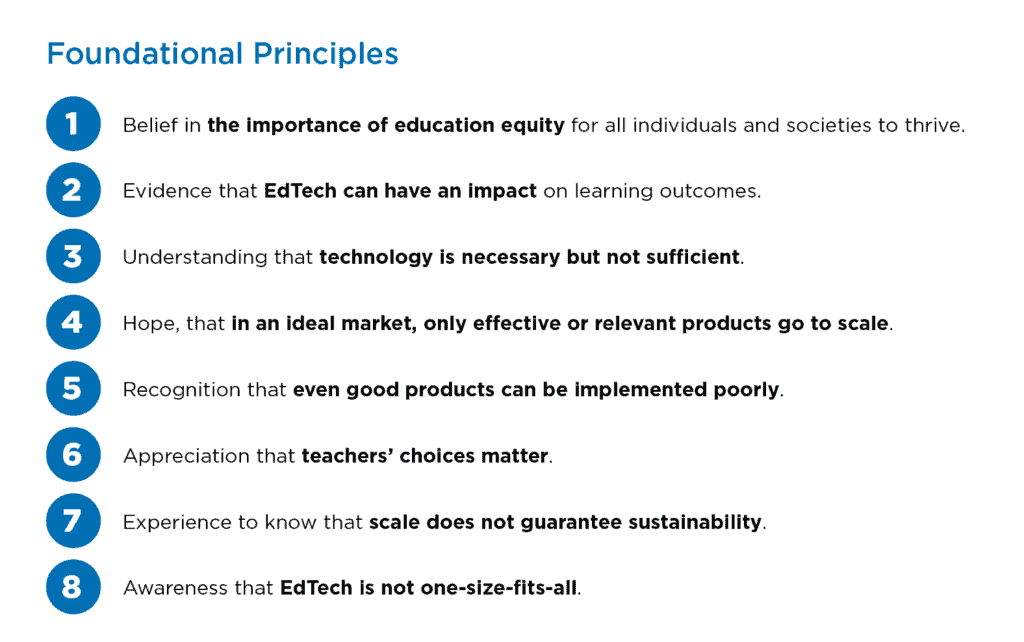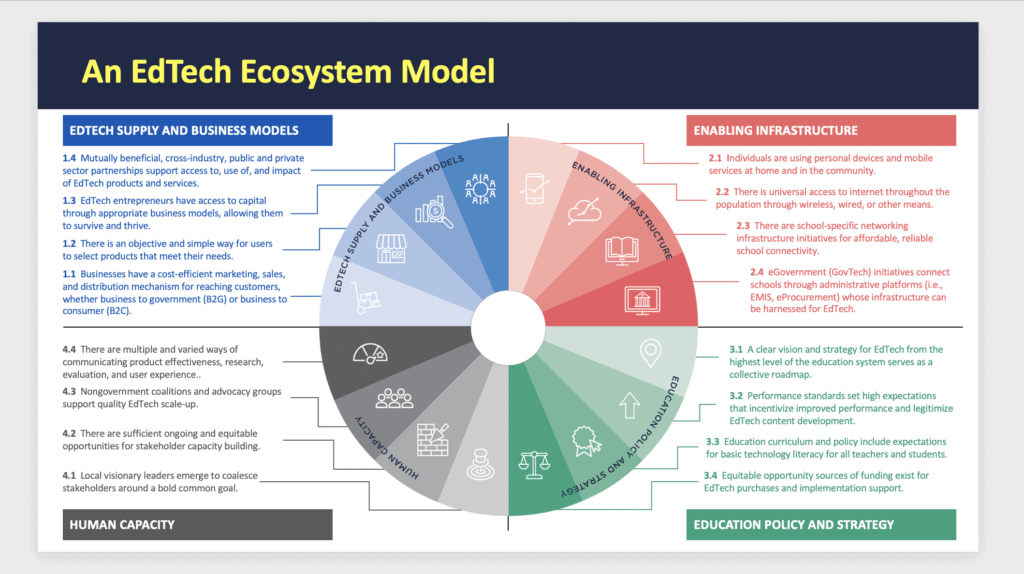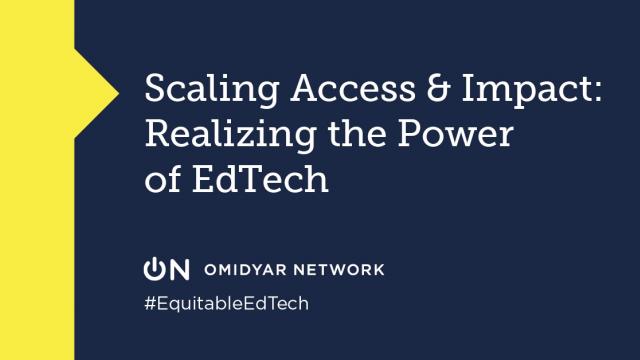With excitement, we share our new report, Scaling Access & Impact: Realizing the Power of EdTech, one of the most ambitious deep dives to date into the world of education technology (EdTech).
We know that technology, when thoughtfully deployed, can be a powerful tool to improve learning outcomes for children in every corner of the globe. And, we also know that too often, technology is not equally distributed leading to huge disparities between access and use of technology by higher income versus lower income children. At Omidyar Network, we believe that in order for EdTech to live up to its true potential, it must be what we call Equitable EdTech — it must improve education for all children, regardless of their family income or location. An emerging body of evidence suggests that Equitable EdTech solutions can bring learning gains to lower income students at reasonable cost.
One example that showcases this is Onion Math, which began in China as a nongovernmental organization that provided tablets to rural schools. They quickly recognized that while hardware was becoming increasingly widespread, there was a critical need for more equitable distribution of high-quality learning content. With this realization, the organization pivoted, and now provides middle school mathematics instruction to students and schools, with more than half of the content available at no cost. Further, more than half of Onion Math’s 15 million plus users are located in areas of need across China — specifically third-tier, and smaller, cities.
Our goal is to foster these innovative EdTech ideas that can “leapfrog” current education realities and produce stronger and more rapid results for all learners, even those many students several years behind grade level or who are currently neglected by the traditional system.
But how to incorporate Equitable EdTech into an education system on a national basis? It turns out, the key is in the ecosystem, the multiple actors — in this case that includes government bodies, educators, innovators, investors, and philanthropies — who need to not only align but to collaborate to create an environment where Equitable EdTech can thrive.

Making the Model — How We Conducted the Research
Working with researchers at RTI International, we studied EdTech across four countries, which have scaled use of EdTech nationally — Chile, China, Indonesia, and the United States. The four case countries represent vastly different population sizes, education system characteristics, and economic indicators. The four countries also vary in terms of the types of EdTech that scaled successfully. Our goal was to highlight what worked best in each location in order to build a model that a range of countries could use to help make Equitable EdTech a primary tool for improving education.
Through interviews with more than 100 teachers, school administrators, policy makers, philanthropists, and EdTech entrepreneurs, we found that while each country’s journey was very different, key factors were necessary to activate an EdTech ecosystem that is both scalable and sustainable.
Building A Strong Ecosystem — Pinpointing Key Drivers
We found that the key drivers to create such an ecosystem are: a vibrant marketplace for education innovations and EdTech entrepreneurs; a technology infrastructure to support the distribution and use of EdTech; a bold EdTech policy that is backed by legislation and fair funding; and committed leaders and educators at every level who have the skill and passion to bring this vision to life.

Within the four broad categories, we have identified 16 components that will help countries succeed. For example, when it comes to building viable business models for EdTech entrepreneurs, there has to be a simple way for users to select products that meet their needs. To enable a strong infrastructure, a country needs universal access to the internet and affordable, reliable school-specific networks. To align the ecosystem, the government needs to document a bold vision in long-term policy.
Thinking Globally — Five Takeaways
The report confirms the power of thinking globally when it comes to changes in education and suggests that innovation can come from a range of geographies and evolve successfully along different paths. Here are five key learnings we surfaced:
1. No one market dynamic is best. China and Indonesia paint a compelling picture of the power of the consumer, while Chile and the United States describe systemic change within systems of schooling.
2. Policy and legislation are catalytic. Indonesia, for example, has rapidly expanded access through organic use of consumer e-learning platforms but will be hard-pressed to scale transformative use, including in schools, without a national policy and vision.
3. Infrastructure and human capacity work hand-in-hand. When thinking about effective implementation, Chile’s approach to EdTech shows that EdTech can scale through programs that deliberately combine hardware and teacher training.
4. Put learners (end users) at the center. In all four of the countries we studied, despite the massive adoption of technology, there are few practical platforms, even in the US, that let users know which products are most effective.
5. There is no one size fits all approach or step-by-step playbook. Instead, the diversity of ecosystem evolutions across the countries we studied, reveal that there are a number of paths that are possible to pursue when getting started.
Aligning for Action — The Power of Ecosystems
Keep in mind, ecosystem health is our goal, and perfection is not a requisite for success here. None of the countries we studied excelled at every component of the model. Instead, the model should be viewed as a guide to help countries as they build out their EdTech ecosystems. It’s a way for stakeholders to get started and think about activating, sometimes unlikely, partnerships. By bringing disparate players together with a common understanding of what the ecosystem is hoping to accomplish, policymakers, entrepreneurs, and educators will be better positioned to create Equitable EdTech that will help students across the education spectrum.
EdTech has the exciting potential to transform learning experiences for students in every corner of the globe. We encourage countries to take a holistic, ecosystem approach to deliver on the promise to prepare future citizens for a global, ever-changing world.
Read more and download the Executive Summary of Scaling Access & Impact: Realizing the Power of EdTech. This is the first in a series of six publications related to this report. For more information on this report or to gain access to future reports in the series, please email [email protected] and follow the conversation at #EquitableEdTech.

